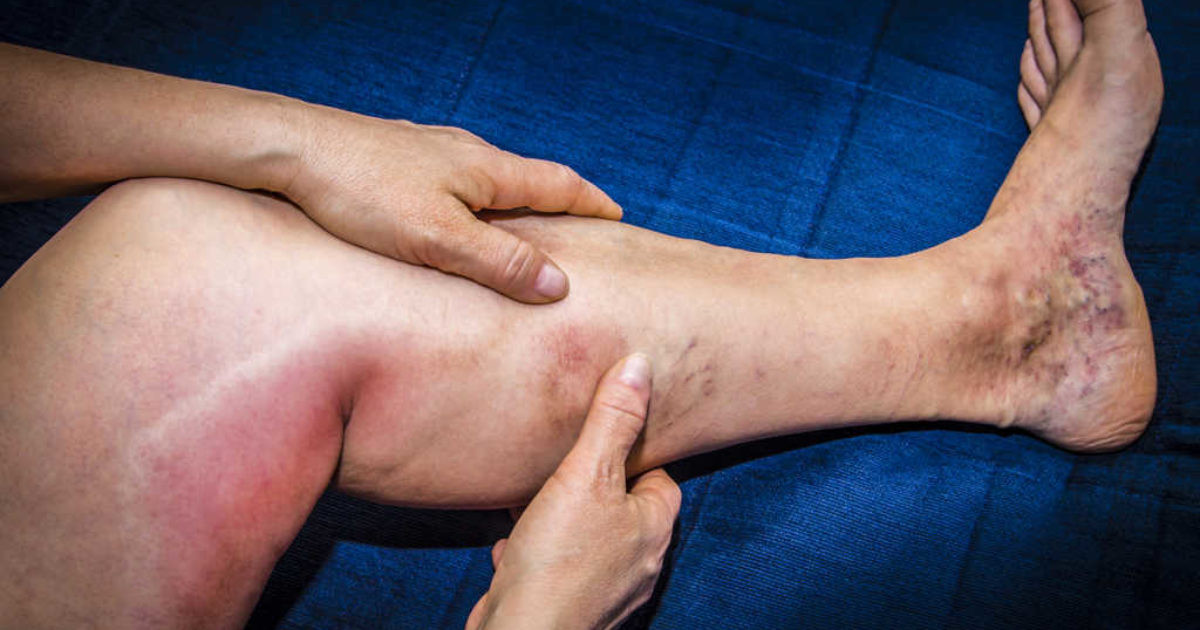Definisi
Trombosis vena dalam (Deep Vein Thrombosis, DVT) merupakan suatu kondisi yang terjadi ketika bekuan darah (trombus) terbentuk di satu atau lebih pembuluh darah balik (vena) dalam di tubuh. Bekuan darah ini biasanya terbentuk di paha, panggul, atau kaki bagian bawah, tetapi juga dapat terjadi di area lain dari tubuh Anda. Trombosis vena dalam dapat menyebabkan timbulnya rasa nyeri atau pembengkakan pada kaki, walaupun juga dapat terjadi tanpa gejala.
Trombosis vena dalam biasanya terjadi jika Anda memiliki kondisi medis tertentu yang memengaruhi proses pembekuan darah. Pembekuan darah di kaki juga bisa terjadi jika Anda tidak bergerak dalam waktu lama, seperti setelah menjalani operasi atau kecelakaan, saat bepergian jauh, atau saat berbaring lama di tempat tidur. Kondisi ini bisa sangat berbahaya karena bekuan darah di dalam pembuluh darah Anda bisa lepas, mengalir melalui aliran darah, dan tersangkut di paru Anda dan menghalangi aliran darah ke paru (emboli paru).
Selain pada vena dalam, pembentukan bekuan darah juga dapat terjadi pada pembuluh darah vena yang berada lebih dekat dengan permukaan kulit. Jenis bekuan darah ini biasanya tidak akan mengalir ke paru kecuali bila bekuan darah berpindah ke vena dalam terlebih dahulu.
Penyebab
Trombosis vena dalam disebabkan oleh adanya bekuan darah di dalam pembuluh darah vena. Bekuan darah itu akan menghambat aliran darah di dalam tubuh. Pembekuan darah dapat disebabkan oleh beberapa hal, termasuk:
1. Cedera
Kerusakan pada dinding pembuluh darah dapat mempersempit atau menghalangi aliran darah dan bekuan darah dapat terbentuk sebagai akibatnya.
2. Pembedahan
Pembuluh darah dapat mengalami perlukaan selama operasi, dan hal ini dapat menimbulkan pembentukan bekuan darah. Berbaring di tempat tidur dengan dan sedikit atau tidak bergerak setelah operasi juga dapat meningkatkan risiko terbentuknya pembekuan darah.
3. Penurunan Mobilitas
Ketika Anda sering duduk terlalu lama, darah dapat menumpuk di kaki Anda, terutama pada bagian bawah. Jika Anda tidak dapat bergerak untuk waktu yang lama, aliran darah di kaki Anda bisa melambat. Hal ini dapat menyebabkan terbentuknya bekuan darah.
4. Obat-obatan Tertentu
Beberapa obat dapat meningkatkan kemungkinan darah Anda menggumpal dan membentuk bekuan darah.
Faktor Risiko
Banyak faktor yang dapat meningkatkan risiko Anda terkena trombosis vena dalam. Semakin banyak faktor risiko yang Anda miliki, maka semakin besar risiko Anda mengalami trombosis vena dalam. Faktor risiko dari trombosis vena dalam meliputi:
- Usia lebih dari 60 tahun
- Duduk dalam waktu lama, seperti saat mengemudi atau duduk di dalam pesawat, karena terjadi penurunan kontraksi otot yang akanmenurunkan sirkulasi darah di kaki
- Berbaring lama di tempat tidur, seperti selama dirawat di rumah sakit dalam waktu lama atau mengalami kelumpuhan
- Cedera atau pembedahan pada pembuluh darah dapat meningkatkan risiko terbentuknya pembekuan darah
- Kehamilan dapat meningkatkan tekanan pada pembuluh darah di panggul dan kaki, risiko pembekuan darah pada kehamilan dapat berlanjut hingga enam minggu setelah melahirkan
- Pil KB (kontrasepsi) atau terapi penggantian hormon
- Kelebihan berat badan atau obesitas akan meningkatkan tekanan di pembuluh darah di panggul dan kaki Anda
- Merokok dapat memengaruhi proses pembekuan darah, sehingga dapat meningkatkan risiko trombosis vena dalam
- Kanker jenis tertentu dapat meningkatkan zat dalam darah yang menyebabkan darah mudah menggumpal
- Gagal jantung akan meningkatkan risiko terjadinya trombosis vena dalam dan emboli paru
- Penyakit radang usus seperti penyakit Crohn atau kolitis ulseratif
- Riwayat pribadi atau keluarga dengan trombosis vena dalam atau emboli paru
- Faktor genetik yang diturunkan dalam keluarga atau kelainan genetik yang membuat darah menjadi lebih mudah menggumpal
- Tidak ada faktor risiko yang diketahui, terkadang bekuan darah di pembuluh darah dapat terjadi tanpa faktor risiko yang jelas
Gejala
Gejala trombosis vena dalam hanya dialami oleh sekitar setengah dari orang yang memiliki kondisi ini. Gejala trombosis vena dalam yang umum meliputi:
- Pembengkakan yang umumnya terjadi di satu sisi kaki, pergelangan kaki, atau tungkai
- Kram di kaki yang sakit yang biasanya dimulai di betis
- Nyeri hebat yang tidak dapat dijelaskan di kaki dan pergelangan kaki
- Area kulit yang terasa lebih hangat daripada kulit di sekitarnya
- Kulit di daerah yang terkena menjadi pucat atau berwarna kemerahan atau kebiruan, tergantung warna kulit
Trombosis vena dalam atau bekuan darah yang terjadi pada anggota gerak bagian atas, seperti di lengan, mungkin tidak menunjukkan gejala. Jika timbul gejala, biasanya keluhan yang terasa antara lain:
- Nyeri pada leher
- Nyeri pada bahu
- Bengkak di lengan atau tangan
- Warna kulit berwarna biru atau lebih gelap
- Rasa sakit yang bergerak dari lengan atas ke lengan bawah
- Kelemahan di tangan
Diagnosis
Dalam mendiagnosis trombosis vena dalam, dokter akan mulai dengan melakukan wawancara dengan Anda. Dokter akan menanyakan gejala-gejala yang Anda alami, serta faktor-faktor risiko yang mungkin Anda miliki. Selanjutnya, dokter akan melakukan pemeriksaan fisik. Dokter akan memeriksa area tubuh yang mengalami pembengkakan, bila terdapat nyeri tekan atau perubahan warna pada kulit di area tersebut.
Dokter juga mungkin melakukan beberapa pemeriksaan penunjang untuk mendiagnosis dan menyingkirkan kemungkinan penyakit lain, seperti:
1. Tes Darah D-dimer
D-dimer adalah sejenis protein yang diproduksi oleh bekuan darah. Hampir semua penderita trombosis vena dalam mengalami peningkatan kadar D-dimer dalam darah.
2. USG Dupleks
Pemeriksaan ini menggunakan gelombang suara untuk menunjukkan gambaran bagaimana darah mengalir melalui pembuluh darah Anda. Pemeriksaan ini adalah tes standar untuk mendiagnosis trombosis vena dalam. Dalam pemeriksaan, pemeriksa akan dengan lembut menggerakkan sebuah perangkat pada kulit Anda di atas area tubuh yang sedang diperiksa.
3. Venografi
Zat pewarna akan disuntikkan ke dalam pembuluh darah besar di kaki atau pergelangan kaki Anda. Kemudian, sinar-X akan digunakan untuk menghasilkan gambaran pembuluh darah di kaki, agar dapat mencari bekuan darah. Pemeriksaan ini cukup jarang dilakukan. Pemeriksaan lain, seperti USG, lebih sering dilakukan terlebih dahulu.
4. MRI
Tes ini dapat dilakukan untuk mendiagnosis trombosis vena dalam pada pembuluh darah perut.
Tata Laksana
Tujuan tata laksana dari trombosis vena dalam adalah untuk menghentikan bekuan darah menjadi lebih besar atau pecah dan mengalir ke paru, serta mencegah timbulnya trombosis vena dalam di kemudian hari. Tata laksana trombosis vena dalam dapat berupa:
1. Obat-obatan
Pengencer darah adalah obat yang paling umum digunakan untuk mengobati trombosis vena dalam. Obat ini dapat mengurangi kemampuan darah Anda untuk membeku. Anda mungkin perlu meminumnya selama 6 bulan. Jika gejala Anda bertambah parah atau bekuan darah sangat besar, dokter mungkin akan memberikan obat untuk menghancurkan bekuan darah. Akan tetapi, golongan obat ini memiliki efek samping yang serius seperti pendarahan mendadak, sehingga tidak rutin diberikan.
2. Filter Vena Cava Inferior
Pembuluh darah balik vena cava inferior merupakan salah satu pembuluh darah vena besar yang berjalan menuju jantung. Jika Anda tidak dapat mengonsumsi pengencer darah atau jika tidak ada perbaikan yang terjadi setelah pemberian terapi, dokter mungkin memasukkan filter kecil berbentuk kerucut di dalam pembuluh darah ini. Filter tersebut dapat menangkap bekuan darah besar sebelum mencapai paru.
3. Stoking Kompresi
Kaus kaki khusus ini sangat ketat pada bagian pergelangan kaki dan lebih longgar di bagian lutut. Penggunaan stoking ini akan memberikan tekanan untuk mencegah darah berkumpul di pembuluh darah.
Komplikasi
Komplikasi dari trombosis vena dalam dapat meliputi:
- Emboli paru, yang terjadi ketika pembuluh darah di paru tersumbat oleh bekuan darah yang mengalir ke paru dari bagian tubuh lain, biasanya dari kaki Anda
- Sindrom pascaflebitis, yaitu kerusakan pada pembuluh darah akibat bekuan darah yang mengurangi aliran darah di daerah yang terkena, menyebabkan nyeri pada kaki dan bengkak, perubahan warna kulit, dan luka pada kulit
Pencegahan
Beberapa hal yang dapat Anda lakukan untuk menurunkan risiko terjadinya trombosis vena dalam, antara lain:
- Latih otot kaki bagian bawah jika Anda perlu duduk diam dalam waktu yang lama. Berdiri dan berjalanlah setidaknya setiap setengah jam jika Anda berada dalam penerbangan panjang atau keluar dari mobil setiap jam jika Anda melakukan perjalanan darat yang jauh
- Bangun dari tempat tidur dan bergerak sesegera mungkin setelah Anda menjalani operasi. Semakin cepat Anda bergerak, semakin kecil kemungkinan Anda mengalami trombosis vena dalam
- Minum obat secara rutin atau gunakan stoking kompresi (jika diresepkan oleh dokter Anda) untuk mengurangi risiko pembekuan
- Berhenti merokok
- Kurangi berat badan jika mengalami obesitas
Kapan Harus ke Dokter?
Konsultasikan diri Anda ke dokter jika mengalami gejala-gejala yang mengarah ke trombosis vena dalam.
Mau tahu informasi seputar penyakit lainnya? Cek di sini, ya!
- dr Hanifa Rahma
Beckerman, J. Deep Vein Thrombosis (DVT). (2020). Retrieved 6 April 2022, from https://www.webmd.com/dvt/what-is-dvt-and-what-causes-it
CDC. What is Venous Thromboembolism?. (2020). Retrieved 6 April 2022, from https://www.cdc.gov/ncbddd/dvt/facts.html
Deep Vein Thrombosis (DVT). (2019). Retrieved 6 April 2022, from https://my.clevelandclinic.org/health/diseases/16911-deep-vein-thrombosis-dvt
Deep Vein Thrombosis (DVT). (2020). Retrieved 6 April 2022, from https://www.mayoclinic.org/diseases-conditions/deep-vein-thrombosis/symptoms-causes/syc-20352557
Delgado, A., et al. Everything You Want to Know About Deep Vein Thrombosis (DVT). (2021). Retrieved 6 April 2022, from https://www.healthline.com/health/deep-venous-thrombosis
Felman, A. What to Know About Deep Vein Thrombosis. (2021). Retrieved 6 April 2022, from https://www.medicalnewstoday.com/articles/153704
Waheed, SM., et al. Deep Vein Thrombosis. (2021). Retrieved 6 April 2022, from https://www.ncbi.nlm.nih.gov/books/NBK507708/












